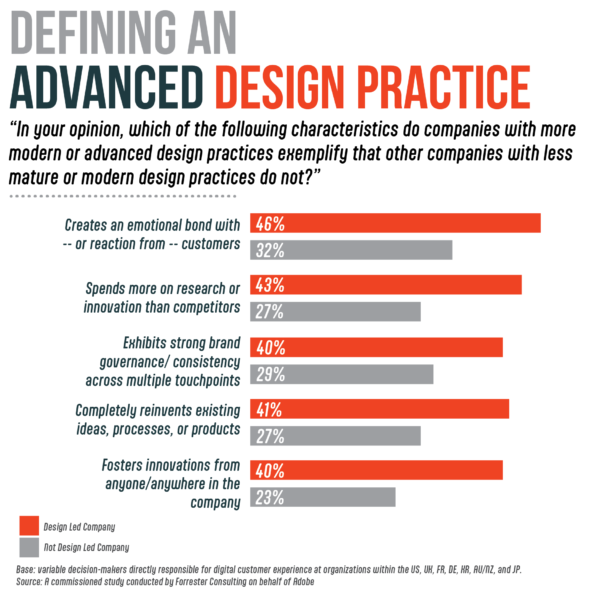The human brain is wired to recognize and react to visual stimuli. Therefore, the importance of design in business is more of a “must have”, than a “nice to have.” Good design increases the effectiveness of attraction, cues emotional responses and emphasizes key information through hierarchical organization. As competition for consumer attention intensifies, companies that are led by design are outperforming their non-design-led competition.
STRANGE BEDFELLOWS?
At first glance, nothing would seem more diametrically opposite than the philosophies of Business and Design. Commerce and bottom line analytics are the ground work that conjure images of stuffy suits associated with “business types.” While the ethereal artist, dressed in their black turtleneck having a penchant for lattes, seems to be the ideal photo adjacent to the word “designer” in the dictionary. In the 21st century, businesses that understand the symbiosis between the two as necessity are leading in their respective divisions and dominating their market share. It’s not just about looking better to a customer, it’s about feeling better to a customer. Introducing design thinking to every aspect of a company can induce a design led culture that excites everyone from employee to end consumer.
MORE THAN JUST ART
The misconception exists that designers just make things look good. Truth be told, a lot of the choices that designers make, sprout from the artist’s desire to create meaningful experiences for an audience. Making something look good is only the surface of what we do. Creating functional and enjoyable experiences takes insight, observation and organization. The Bachman team understands the impact we can contribute to business with our craft. Our knack for creative thinking helps us identify and solve problems, current and future. We are driven by a quest for the premiere solution.
PAIRITY AND THE SKEPTICAL CONSUMER
It’s not a stretch to say that we’ve all become more jaded and skeptical of claims. Consumer trust continues to trend downward. Your product alone cannot sell itself. It is the promise of your brand and the design experience a consumer has before, during and after purchase, that differentiates. Creative Review has gone so far as to say that users (consumers) “expect better, deserve better, demand better.” It is no longer “optional” to have good design in business. It is the new, expected benchmark. A well-designed message that is engaging and consistent are imperative to success.
5 STATISTICS THAT ILLUSTRATE THE IMPORTANCE OF DESIGN IN BUSINESS
- Strong design increases recognition and revenue. Keeping brand standards consistent across all communications not only enhances recognition but a proven 33% increase in revenue.
- Companies that have consistently exhibited strong design outperform lesser design-centric companies by 228% on the S&P index
- Strong design differentiates you from your competition. With so much parity among products, a 2022 global survey revealed, five out of 10 consumers would be willing to spend extra for a brand with an image that appealed to them.
- Design influences more than just customer behavior. “Strong brands enhance business performance primarily through their influence on customers, employees, and investors.”
- Design creates greater market share, a competitive advantage and more loyal customers. study

WHAT IS A DESIGN-LED COMPANY
Companies that place emphasis on brand design are design-led. When you weave principles of design into everything from research and strategy to content and communications, you become a design-led company. Bachman Brand Development has been a force in helping businesses evolve by infusing our design process into their curriculum. Our team asks a lot of questions but more importantly, we listen. Our holistic approach can create strong relationships with your customers, employees and stakeholders.
THE VALUE OF DESIGN IS ILLUSTRATED BY FOUR THEMES OF DESIGN LED COMPANIES.
-
-
-
- Analytical Leadership Measure and drive design performance with the same rigor as revenues and costs
- Cross-functional talent Make user-centric design EVERYONE’S responsibility, not a siloed function.
- Continuous Iteration De-risk development by listening, testing and iterating with customers and end users.
- User Experience Consistent messaging internally and externally across all platforms and connections.
-
-
“Amateurs give advice, experts diagnose.”
Chris Do, founder and CEO of Blind
At Bachman, we diagnose before we design. We’re a compact and dedicated team, agile enough to handle any scope of project with efficiency, focus and a savvy that others don’t possess. Start the conversation and see what makes us a trusted business partner for some of the most recognizable brands.

